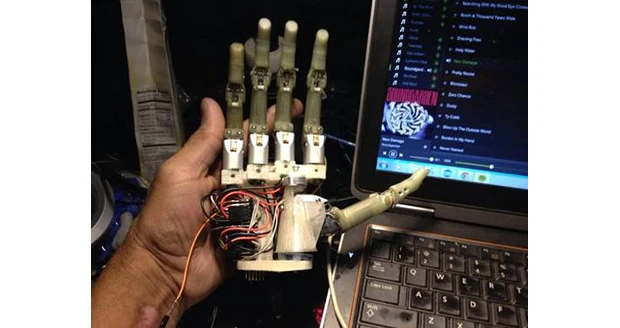
One sunny Thursday afternoon last October, Lyman Connor climbed on his bicycle and pedaled from his Roanoke, Va., home for a ride along the scenic Blue Ridge Parkway. He didn’t make it back that day.
Riding down one of the parkway’s steep hills at nearly 40mph, a car suddenly braked in front of Connor. “The last thing I remember was going over the handlebars,” he says. “When I woke up in an intensive care unit, I had tubes coming out my body to sustain my breathing.”
Connor suffered nine skull fractures in the fall and broke his hip, jaw, clavicle and a number of ribs, one of which punctured a lung. He also lost sight in one of his eyes and his sense of taste.
After spending a week convalescing in the hospital, the 54-year-old Connor decided to go home. He was still badly hurting and in a cast when he stepped into the hospital elevator. Inside was a boy whose eyes were red from crying. “I tried to make him smile, pointed to myself, and told him it couldn’t be so bad,” Connor says.
But the boy lifted his arm and showed Connor a stump where his hand should have been.

“He said that at least I had both hands,” Connor recalls. “I didn’t know how to respond.”
Connor gathered from the conversation that the boy’s family could not afford to buy him an electronic prosthetic hand, which can cost as much as $75,000. So he decided to build one for the boy. “There are moments in life that give you a chance to change directions,” Connor says. “This was one of them.”
Connor, a GE engineer who writes software for turbines and power plants, has always been a tinkerer. Among the tools in his garage is a 3D printer, which he decided to use to build a low-cost bionic hand. “I didn’t want the boy to be denied a hand because his family didn’t have the money,” he says.
He searched the Internet and found a page for Robohand, an open-source project that is developing 3D-printed limbs in South Africa. This group’s work gave him the initial blueprints for printing fingers. Then he learned about wrist design and the circuits that go inside bionic hands from the Michigan Institute for Electronic Limb Development. He also talked to prosthetists and patients at a local V.A. hospital.
High-end electronic limbs use sensors that detect electric signals generated by muscles in the stump to control the prosthesis. But Connor was surprised to learn that some people who had lost a hand would be willing to control their prosthesis with their healthy hand. “One man told me to build him a smartphone app,” he says. “So that’s exactly what I did.”

Connor invested about $10,000 of his own money in the project and was loath to spend another $4,000 on getting a programmer to develop the app. So he taught himself how to code on his own. “You don’t need to be a genius to do this, just resourceful” he says.
Connor’s quest also took him to the heart of the maker movement, a diverse group of tinkerers, hobbyists and DIY entrepreneurs. One such community is called TinyCircuits, which makes open-source miniature computer boards in Akron, Ohio. Tiny Circuits designed for Connor with his input, a miniature singleboard solution based on its TinyDuino, a quarter-sized board based on the Arduino microcontroller, to manipulate the hand with his app over a Bluetooth connection. A Roanoke machine shop then built him metal joints and other parts needed for the hand.
The bionic hand is now almost ready. Its mechanical and electronic parts are all done. All that remains is to make the prosthesis’s plastic skin, a job made more difficult since Connor’s 3D printer broke. “I take it one step at a time,” he says. “I’ll sell a couple of my bikes and buy a nice high-resolution FormLabs printer that got recently funded on Kickstarter.”
Connor’s finished hand will come as a kit and should cost around $4,000. Its parts can be replaced when they break. “I wanted to build an affordable device that could be manufactured anywhere,” he says. “There are a lot of people around the world who need this.”

Connor returned to his job at GE in January after recuperating from his accident nine months ahead of schedule. He regained his sight and sense of smell albeit he has shed 35 pounds since being injured, weight loss he attributes to the loss of his sense of taste. “Everything used to taste like oatmeal to me,” he says. “My friends come here and say, ‘Man, you are dying.’ But actually this project gave new meaning to my life.”
He continues: “I never wanted any accolades. This is no feel good story and I am not doing it for money. I want people to dig inside and see what they can do for others.”
Connor still has one last big item on his to-do list. He never took down the name and the address of the boy in the elevator. “I hope that this story will help me find him,” he says. “I’ve got his new hand in my workshop. It’s almost ready.”
Source: GEReports
Latest from Today's Medical Developments
- CMMC Roll Out: When Do I Need to Comply? webinar
- Metabolic research uses Siemens gas analyzers to deliver results with 99.9999% resolutions
- Mazak’s SYNCREX 38/9 Swiss-type production turning machine
- Current economic and geopolitical realities demand decisive action
- Collaboration to advance pediatric medical technologies
- Guyson's TR-1000 Custom Vertical Blast System
- Intelligent data for the digital factory
- Edge Technologies' latest barfeeders





